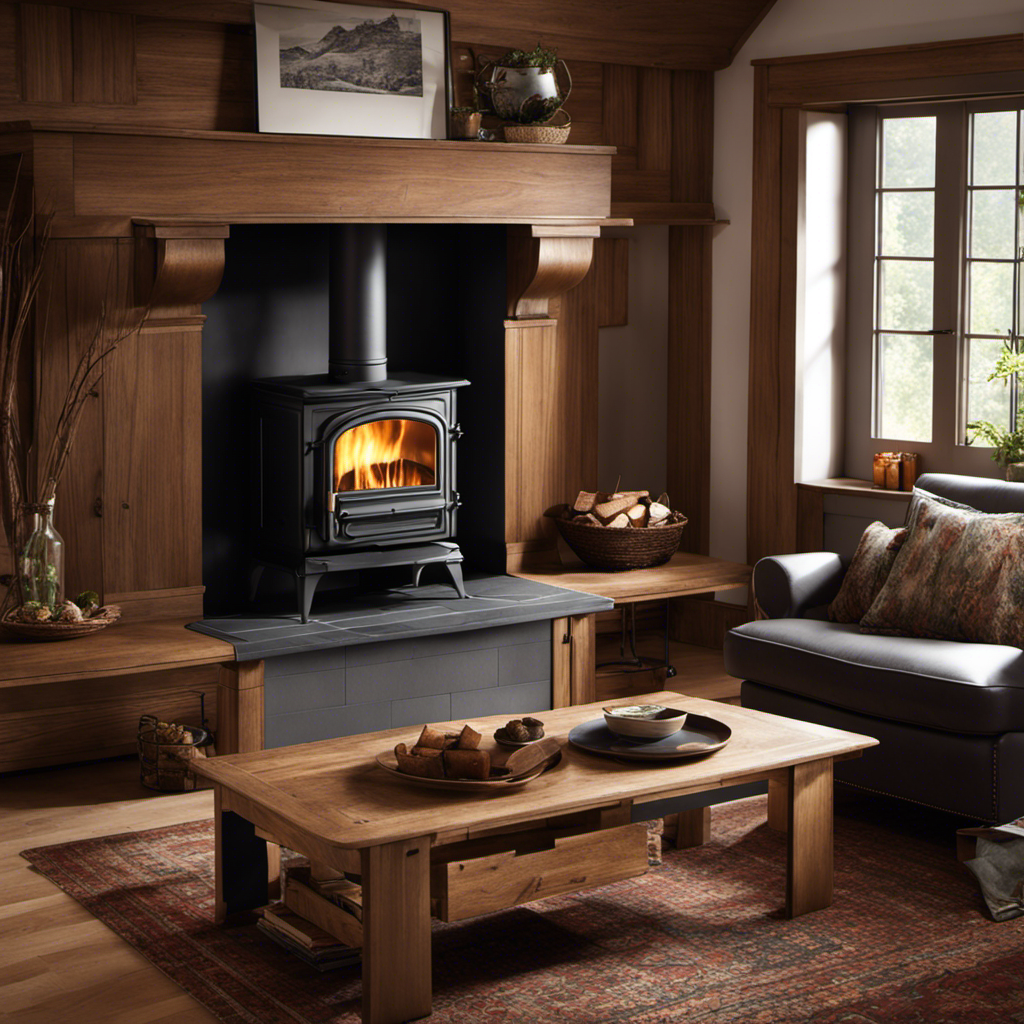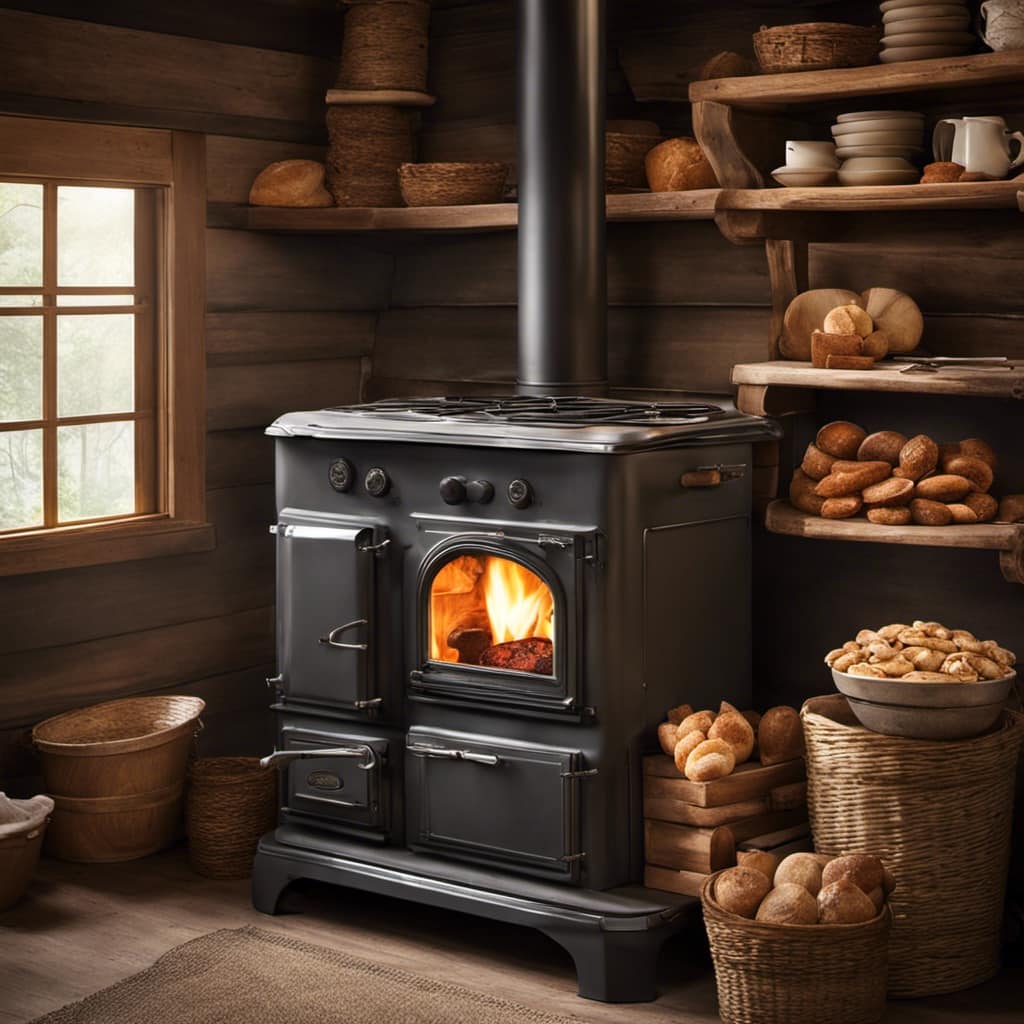As a homeowner, I have always followed the advice of “better safe than sorry,” particularly when it comes to the installation of a wood stove. Therefore, what is the recommended distance between a wood stove and a wall?
In this article, we’ll explore the minimum clearance requirements, fire safety regulations, and factors to consider when determining the distance between your wood stove and a combustible wall.
Stay tuned to ensure a safe and cozy home heating experience.
Key Takeaways
- Wood stoves should have a minimum clearance of 36 inches from combustible walls.
- Consult the manufacturer’s instructions and local building codes for specific clearance requirements.
- Non-combustible materials such as heat shields can be used to reduce the required clearance distance.
- Regularly inspect and maintain the wood stove to ensure proper functioning and prevent the risk of accidental fires.
Minimum Clearance Requirements for Wood Stove Placement
What are the minimum clearance requirements for placing a wood stove?
When it comes to fire safety and complying with building code requirements, it’s crucial to ensure that a wood stove is installed with proper clearance. The minimum clearance requirements vary depending on the specific stove and the type of wall it’s placed against.
Generally, wood stoves should have a minimum clearance of 36 inches from combustible walls. This distance helps prevent the risk of fire and allows for proper airflow around the stove. However, it’s important to consult the manufacturer’s instructions and local building codes for specific clearance requirements.
Additionally, non-combustible materials such as heat shields can be used to reduce the required clearance distance.
Following these minimum clearance requirements ensures a safe and compliant wood stove installation.
Fire Safety Regulations for Wood Stove Clearance
I am currently discussing the importance of adhering to fire safety regulations for wood stove clearance. Proper wood stove installation is crucial to ensure the safety of both the occupants and the surrounding environment. Here are three key fire safety precautions to consider:
-
Maintain proper clearance: It’s essential to follow the manufacturer’s guidelines for the minimum distance between the wood stove and combustible materials such as walls, furniture, and flooring. This clearance helps prevent the risk of accidental fires.
-
Use non-combustible materials: When installing a wood stove, it’s crucial to use non-combustible materials for the surrounding area. This includes heat-resistant materials for the wall, floor, and any other surfaces near the stove.
-
Regular maintenance and inspections: Regularly inspecting and maintaining the wood stove is vital to ensure its proper functioning. This includes checking for any cracks, leaks, or damage and cleaning the stove and chimney regularly to prevent the buildup of flammable substances.
Factors to Consider When Determining Wood Stove Distance From Wall
One important factor to consider when determining the distance between a wood stove and the wall is the manufacturer’s recommended minimum clearance of at least 12 inches. This safety precaution is crucial to prevent any potential fire hazards and ensure the proper functioning of the wood stove. However, there are other factors to consider as well. These include the type of wall material, heat shielding options, and local building codes. For example, if the wall is made of combustible material such as wood, additional clearance may be required. It is also important to install heat shielding options, such as a non-combustible hearth pad or a heat shield on the wall, to further enhance safety. Additionally, local building codes may have specific requirements regarding wood stove clearances that must be adhered to. By considering these factors and following the necessary safety precautions, one can ensure a safe and efficient wood stove installation.
| Factors to Consider | Safety Precautions |
|---|---|
| Manufacturer’s recommended minimum clearance | Install heat shielding options |
| Type of wall material | Follow local building codes |
Recommended Distance Between Wood Stove and Combustible Wall Materials
I always make sure to follow the recommended distance between my wood stove and combustible wall materials to ensure a safe and fire-free environment. Maintaining safe clearances is crucial when installing a wood stove, as it reduces the risk of heat transfer to nearby walls and minimizes the chance of ignition.
Here are three key points to consider regarding the recommended distance:
-
Manufacturer’s Specifications: It’s essential to refer to the manufacturer’s guidelines for the specific wood stove model. They provide specific recommendations for the safe clearance distance required between the stove and combustible wall materials.
-
National Fire Protection Association (NFPA) Standards: The NFPA provides standards and guidelines for the installation of wood stoves. These guidelines include recommendations for safe clearances to ensure proper ventilation and prevent potential fire hazards.
-
Local Building Codes: Always check with your local building codes and regulations. They may have specific requirements for safe clearances that need to be followed to ensure compliance and safety.
Maintaining Safe Clearances for Wood Stove Installation
Maintaining safe clearances for wood stove installation is essential, but it requires careful consideration and adherence to recommended guidelines.
To ensure a safe installation, it’s crucial to understand the clearance measurements required for wood stoves. These clearance measurements refer to the minimum distance that should be maintained between the stove and any combustible materials, such as walls, furniture, or curtains.
Safe installation practices dictate that the recommended clearances should be followed to prevent the risk of fire and ensure efficient operation of the wood stove. The specific clearance requirements may vary depending on the type of stove and the manufacturer’s instructions, so it’s important to consult the product manual or seek professional advice.
Frequently Asked Questions
What Are the Potential Risks or Dangers of Placing a Wood Stove Too Close to a Wall?
Potential consequences of placing a wood stove too close to a wall include increased risk of fire, overheating of the wall, and damage to the surrounding area. Safety precautions such as proper clearance must be followed to prevent these dangers.
Can I Install a Wood Stove in a Small Room With Limited Space Between the Stove and the Walls?
In a small room with limited space, it is crucial to consider the proper installation of a wood stove. Ensuring adequate distance between the stove and walls is essential for safety and preventing potential hazards.
Are There Any Specific Building Codes or Regulations Regarding Wood Stove Placement That I Should Be Aware Of?
Regarding wood stove placement, it is crucial to consider building code requirements and safety precautions. These regulations dictate the minimum distance that a wood stove should be away from a wall to ensure proper ventilation and prevent potential fire hazards.
Can I Use Non-Combustible Materials to Reduce the Required Distance Between the Wood Stove and the Wall?
Yes, using non-combustible materials can reduce the required distance between the wood stove and the wall. This can have a significant impact on room temperature, allowing for more efficient heat distribution.
How Often Should I Check and Maintain the Clearance Between the Wood Stove and the Wall to Ensure Ongoing Safety?
To ensure ongoing safety, I check and maintain the clearance between my wood stove and the wall regularly. This helps prevent any potential fire hazards and ensures that the stove operates efficiently and safely.
Conclusion
In conclusion, it’s crucial to maintain proper clearance between a wood stove and the wall to ensure fire safety. According to fire safety regulations, the minimum distance required is typically around 36 inches.
However, it’s recommended to consult the manufacturer’s guidelines and local building codes for specific requirements. By following these guidelines, we can reduce the risk of fire accidents and ensure the safe installation of wood stoves in our homes.
Logan’s affair with adventure began in childhood. He hailed from a small town where vast forests bordered one side and endless shores stretched on the other. His days were spent exploring uncharted woods, climbing tall trees, or listening to the tales of old sailors. This early immersion in a world brimming with stories and mysteries became the foundation of his passion for writing.











